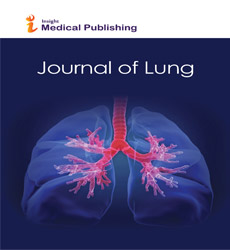Risk factors for short-term lung cancer survival
John son*
Department of Pulmonology, United States
- *Corresponding Author:
- ohnson
DepartmentofPulmonology,UnitedStates
Tel: 972548820015
E-mail:kdg921@georgetown.edu
Received Date: July 15, 2021; Accepted Date: October 18, 2021; Published Date: October 28, 2021
Citation: son J (2021) Risk factors for short-term lung cancer survival J Lung Vol. 2 No: 4.
Commentary
Cellular breakdown in the lungs is commonly analyzed in a high level period of its regular history. Logical models dependent on epidemiological and clinical factors give an estimation of patient endurance short of what one year utilizing data removed from the case history just, though models including restorative factors should affirm that any treatment applied is more regrettable than a medical procedure in endurance terms. Models for grouping short of what one year endurance for patients determined to have cellular breakdown in the lungs which can distinguish hazard factors and evaluate their impact for forecast are dissected. Technique: Two stepwise double strategic relapse models, in light of a review investigation of 521 instances of patients determined to have cellular breakdown in the lungs in the Interventional Pneumology Unit at the Hospital "Virgen de las Nieves", Granada, Spain. Results: The principal model included factors age, history of aspiratory neoplasm, tumor area, dyspnea, dysphonia, and chest torment. The free danger factors age more prominent than 70 years, a fringe area, dyspnea and dysphonia were huge. For the subsequent model, medicines were additionally huge.
Introduction
Cellular breakdown in the lungs is the most widely recognized reason for neoplasm-related demise in all kinds of people, causing around 1.3 million passings each year around the world. Cellular breakdown in the lungs patients experience a wide scope of indications depending, among different components, on the anatomical constructions influenced, with the most well-known being dyspnea, hack, hemoptysis, chest torment, sacred side effects, and dysphonia. Dyspnea is an exceptionally normal side effect in cutting edge cellular breakdown in the lungs, being available in 65% of cases at some phase of the illness and particularly affecting personal satisfaction. Hack, which will in general be brought about by natural or extraneous (adenopathies) block of the windpipe and proximal bronchi, is likewise a typical and irritating side effect for cellular breakdown in the lungs patients and is frequently the principal indication to show up . Hemoptysis is available in 7–10% of cellular breakdown in the lungs patients and is the reason for death in 3% of cases, being more normal in patients with focal injuries of the aviation routes than in those with fringe sores of the pneumonic parenchyma. Chest torment is the most well-known side effect of cellular breakdown in the lungs, being available in around 25% of cases at finding and expanding in commonness as the sickness advances. Protected manifestations, including the presence of asthenia, anorexia, and weight reduction, by and large present in cutting edge phases of cellular breakdown in the lungs and are a significant indicator of mortality. Dysphonia shows up in cellular breakdown in the lungs because of association of the intermittent laryngeal nerve because of metastatic intrusion of the mediastinum, chiefly the one situated in the upper right paratracheal area or in the aortopulmonary window, and by and large infers progressed or non-resectable sickness. The primary therapy alternatives for cellular breakdown in the lungs are a medical procedure, radiotherapy, and chemotherapy, either alone or in blend, contingent upon the stage and histological subtype of the malignancy and the clinical circumstance and general state of the patient. The treatment of these patients has gained critical headway in ongoing a very long time with the rise of explicit changes focusing on treatments (known as designated treatments) and all the more as of late with immunotherapy, being an inexorably normal treatment.
Age, history of aspiratory neoplasm, tumor area, dyspnea, dysphonia, and chest torment are indicators for endurance in patients determined to have cellular breakdown in the lungs at the hour of finding. The treatment applied is critical for characterizing short of what one year endurance time which affirms that any treatment is particularly mediocre compared to a medical procedure as far as endurance.
References
- Caballero-Vázquez A, Romero-Béjar JL, Albendín-García L, Suleiman-Martos N, Gómez-Urquiza JL, Cañadas GR. Risk Factors for Short-Term Lung Cancer Survival. J Clin Med. 2021; 10(3): 519.
- Voltolini L, Bongiolatti S, Luzzi L, Bargagli E, Fossi A, Ghiribelli C, Rottoli P, Gotti G. Impact of interstitial lung disease on short-term and long-term survival of patients undergoing surgery for non-small-cell lung cancer: analysis of risk factors. Eur J Cardiothorac Surg. 2013; 43(1): e17-23.
- Chiyo M, Sekine Y, Iwata T, Tatsumi K, Yasufuku K, Iyoda A, Otsuji M, Yoshida S, Shibuya K, Iizasa T, Saitoh Y. Impact of interstitial lung disease on surgical morbidity and mortality for lung cancer: analyses of short-term and long-term outcomes. J Thorac Cardiovasc Surg.2003; 126(4): 1141-1116.
- Irie M, Nakanishi R, Yasuda M, Fujino Y, Hamada K, Hyodo M. Risk factors for short-term outcomes after thoracoscopic lobectomy for lung cancer. JRes. 2016; 48(2): 495-503
Open Access Journals
- Aquaculture & Veterinary Science
- Chemistry & Chemical Sciences
- Clinical Sciences
- Engineering
- General Science
- Genetics & Molecular Biology
- Health Care & Nursing
- Immunology & Microbiology
- Materials Science
- Mathematics & Physics
- Medical Sciences
- Neurology & Psychiatry
- Oncology & Cancer Science
- Pharmaceutical Sciences
